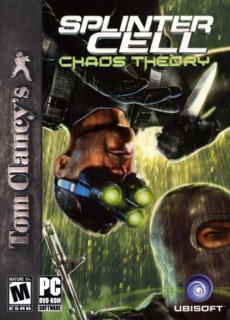The government spent thousands of dollars on an SC-20K that will mainly serve as a way to get you into trouble.
Splinter Cell: Chaos Theory is a graphically amazing game. In fact, it's probably the best-looking current generation game out there (save maybe Ghost Recon: Advanced Warfighter, but that game wouldn't even run on my powerhouse pc). The faces could use a little work, especially in light of facial technology present in games like VALVe's Half-Life 2. The voice acting is spot-on, as usual for the Splinter Cell series, and Sam sounds cynical as ever.
What we've all come to expect from the series so far is a unique, high-tech, stealth spy game. In previous iterations of the series, this usually meant that a good part of the game revolved around NOT killing the terrorists, but rather just knocking them out and stashing them somewhere. Chaos Theory, on the other hand, is much more lenient about letting you kill the bad guys as you see fit. Only a small portion of the missions will require you to avoid fatalities, and it's far less annoying to do so than in the previous two games. Now that you can kill much more freely, Sam actually makes use of the knife that he's bandied about for the entire series, but never actually used before now. Previously, the only time you would ever see the knife was when Sam grabs a terrorist from behind and interrogates them for useful tidbits of information. He still uses it in this capacity in Chaos Theory, but you also get some good throat slashing and back stabbing action, where before there were only punches to the head.
As many games have attempted to do in recent years, Splinter Cell: Chaos Theory gives the player a much more open-ended approach to accomplishing objectives. Stepping away from the formulaic linearity of the original Splinter Cell, and allowing for even more diverse strategies than Pandora Tomorrow, Chaos Theory lets you all but become a real high-tech secret government agent.
The main and only downside to the game's intense stealth-action formula is the action part of the duo. While slinking from corner to corner, backstabbing and stealthy assaults are the name of the game in Chaos Theory, the action is still lacking when it comes to firefights. Basically the only way to avoid numerous frustrating reloads when it comes to open war with your terrorist enemies is to avoid open combat completely. In the event that an enemy ever gets a shot off at you, you had better kill him quick, because if he's allowed to fall back to a covered position, expect him to mow you down with pinpoint precision, even though he couldn't see you at all before. Additionally, all his buddies will come running, and an alarm will inevitably sound.
The system for shooting in Chaos Theory has remained the same as it was in its predecessors, and is truly a relic of the consoles from which it was ported. The aiming system is clunky and totally unsuited for use in a PC shooter. The system is bearable, once you've played for a few hours and popped a couple of satisfying headshots, but it never extends beyond being only bearable. It's something that you're just going to have to put up with, because otherwise the game is great.
You'll have a ton of fun sneaking up on your unsuspecting foes and dispatching them in a number of creative ways, but the lackluster firearm combat in Splinter Cell: Chaos theory prevents it from living up to the great game that it ought to be.

